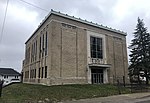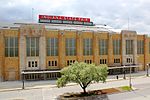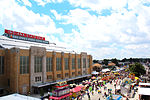Watson Park Historic District

Watson Park Historic District, also known as Watson Road Historic District and Watson McCord Neighborhood, is a national historic district located at Indianapolis, Indiana. The district encompasses 402 contributing buildings and 4 contributing sites in a predominantly residential section of Indianapolis. They include 255 houses, 27 multiple family dwellings, and 120 garages. It was developed between about 1910 and 1960, and includes representative examples of Colonial Revival, Tudor Revival, and Bungalow / American Craftsman style architecture. Located in the district is the Watson Park Bird Sanctuary.It was listed on the National Register of Historic Places in 2012.
Excerpt from the Wikipedia article Watson Park Historic District (License: CC BY-SA 3.0, Authors, Images).Watson Park Historic District
North College Avenue, Indianapolis Watson Park
Geographical coordinates (GPS) Address Nearby Places Show on map
Geographical coordinates (GPS)
| Latitude | Longitude |
|---|---|
| N 39.822222222222 ° | E -86.144444444444 ° |
Address
North College Avenue 3637
46205 Indianapolis, Watson Park
Indiana, United States
Open on Google Maps







